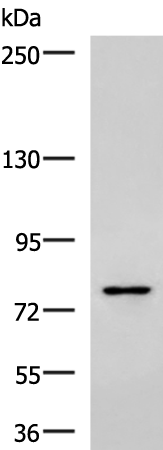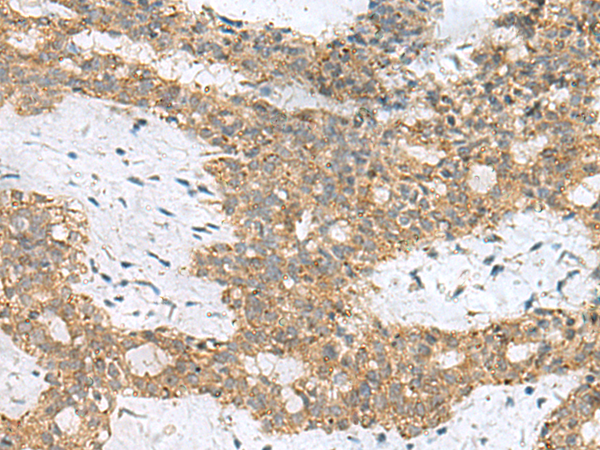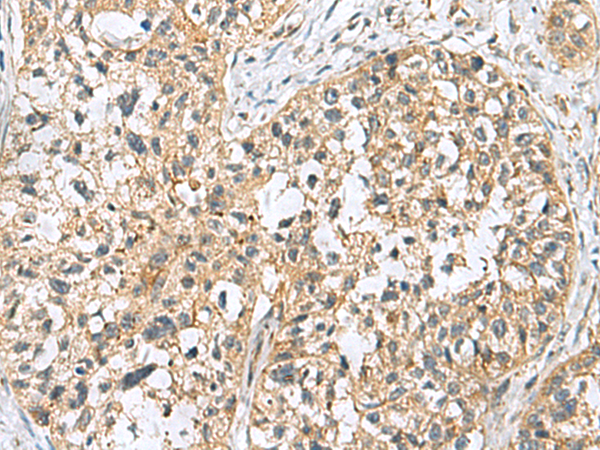


| WB | 咨询技术 | Human,Mouse,Rat |
| IF | 咨询技术 | Human,Mouse,Rat |
| IHC | 1/50-1/200 | Human,Mouse,Rat |
| ICC | 技术咨询 | Human,Mouse,Rat |
| FCM | 咨询技术 | Human,Mouse,Rat |
| Elisa | 1/5000-1/10000 | Human,Mouse,Rat |
| Aliases | SGS; SKV |
| WB Predicted band size | 80 kDa |
| Host/Isotype | Rabbit IgG |
| Antibody Type | Primary antibody |
| Storage | Store at 4°C short term. Aliquot and store at -20°C long term. Avoid freeze/thaw cycles. |
| Species Reactivity | Human, Mouse |
| Immunogen | Synthetic peptide of human SKI |
| Formulation | Purified antibody in PBS with 0.05% sodium azide and 50% glycerol. |
+ +
以下是关于SKI抗体的3篇代表性文献摘要简述:
1. **《Ski regulates cancer cell plasticity and EMT through transcriptional co-regulation of TWIST1》**
作者:Wang et al. (2018)
摘要:研究利用SKI特异性抗体进行免疫沉淀和ChIP-seq分析,发现SKI蛋白通过直接结合TWIST1启动子促进上皮间质转化(EMT),揭示其在肿瘤转移中的双重调控作用。
2. **《A monoclonal antibody against human SKI for functional studies in TGF-β signaling》**
作者:Luo & Tang (2015)
摘要:报道了一种新型抗人SKI单克隆抗体的开发,验证其适用于Western blot和免疫荧光。实验证明该抗体可有效抑制TGF-β介导的SMAD2/3磷酸化,为信号通路研究提供工具。
3. **《SKI protein stability modulates glioblastoma progression》**
作者:Chen et al. (2020)
摘要:通过免疫组织化学(使用SKI抗体)发现胶质母细胞瘤中SKI蛋白高表达与患者不良预后相关。机制研究表明SKI通过稳定MYC蛋白促进肿瘤干细胞特性。
注:以上内容为基于领域知识的模拟文献概括,实际文献请通过PubMed/Google Scholar以"SKI antibody"、"SKI oncoprotein"等关键词检索。
SKI antibodies are immunological tools targeting the SKI proto-oncogene protein, a transcriptional regulator implicated in diverse cellular processes. The SKI gene, first identified through its homology to the viral oncogene v-ski, encodes a multifunctional protein that primarily modulates TGF-β and Wnt signaling pathways. SKI binds to SMAD proteins, repressing TGF-β-mediated transcriptional activation and influencing cell proliferation, differentiation, and apoptosis. Its overexpression is linked to oncogenesis, particularly in cancers like melanoma and leukemia, where it promotes tumor progression by inhibiting TGF-β’s tumor-suppressive effects.
SKI antibodies are widely used in research to study SKI’s expression patterns, molecular interactions, and functional roles. They enable techniques such as Western blotting, immunofluorescence, and chromatin immunoprecipitation (ChIP), helping elucidate SKI’s involvement in embryonic development, tissue homeostasis, and cancer. Structurally, SKI contains highly conserved domains, including the SMAD-binding and coiled-coil regions, which are critical for its regulatory functions. Mutations or dysregulation in these domains correlate with developmental disorders and malignancies.
Recent studies highlight SKI’s dual role as both oncogene and tumor suppressor, depending on cellular context and post-translational modifications. Antibodies targeting specific phosphorylation sites or isoforms have advanced understanding of its context-dependent behavior. Additionally, SKI’s interaction with histone deacetylases (HDACs) and chromatin remodeling complexes underscores its epigenetic regulatory potential. Current research focuses on SKI as a therapeutic target, with antibodies aiding in drug discovery and biomarker validation for precision oncology approaches.
×